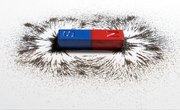
Electric motors, computers, even high-speed trains all use magnets. Fun to play with as a kid or even an adult, the mystery of magnets is an interesting study subject. Magnets attract certain things, repel others and are a necessary component to many of the items we use in daily life. The question of what objects are attracted to magnets leads to surprising results.
Magnetic Elements: Metals
Iron, nickel and cobalt are strongly attracted to magnets. Scientists call these metallic elements "ferromagnetic" because of this strong attraction. The mechanism for making a metal attractive to magnets has to with the arrangement of electrons that orbit the atoms: some arrangements lead to strong magnetism, others don't. Other metals, such as tungsten and lead, also attract magnets, though it is too weak to measure without specialized scientific equipment.
Magnetic Minerals
Certain minerals have attractions to magnetism, some weak, some very strong. Platinum-bearing minerals often have a magnetic attraction usually due to ferrous impurities. Hematite and franklinite display weak magnetic attractions. Lodestone, another name for magnetite, is a highly magnetic mineral, which itself is generally magnetic, hence the name magnetite. A material of interest due to its surprising attraction to magnets is some types of black sand, which is actually crushed magnetite. In highly volcanic areas this sand can be attracted to magnets through liquid, a process that is highly useful in some gold-mining methods, as it pulls impure magnetic sand away from the gold.
Alloys: Metal Mixtures
Magnets will also attract some alloys, or mixed combinations of ferromagnetic metals with other elements, such as carbon and aluminum. The alloy alnico, for example, is a fairly strong and durable magnetic alloy consisting of aluminum, nickel and cobalt. Another alloy, which combines the rare-earth element neodymium with iron and boron, produces the strongest permanent magnets ever made. Without these powerful magnets, products such as quadcopter drones might otherwise be impossible to make. Other alloys, such as certain types of stainless steel, have very weak attraction to magnets, despite containing iron.
Odd Everyday Things
Magnets can attract dollar bills, liquids, particles from your breakfast cereal, even strawberries if the magnet is strong enough. The reason for this is the objects contain particles of ferrous material, often iron, that is attracted to the magnet. Ink in a dollar bill for instance, has iron particles. Breakfast cereal is often fortified with iron, that can leave small particles which will stick to a magnet. Iron naturally occurs in many things such as some liquids or even vegetation, but it takes a very strong magnet to attract the tiny particles in some things and see it in action.
Aurora Borealis
Those who are lucky enough to view this light show in the northern night sky may not realize that the action is the result of magnetism. The Earth itself is surrounded by a magnetic field and is in essence a giant magnet due in part to its molten iron core. The magnetic field around Earth attracts particles, such as those from the solar wind, which interact with the magnetic field and cause the display we call the Northern Lights.
References
About the Author
Caprice Castano recently left the field of construction management to operate her own contracting business and spend time developing her writing career. Current projects include freelance writing for Internet publications and working on novel-length fiction.
